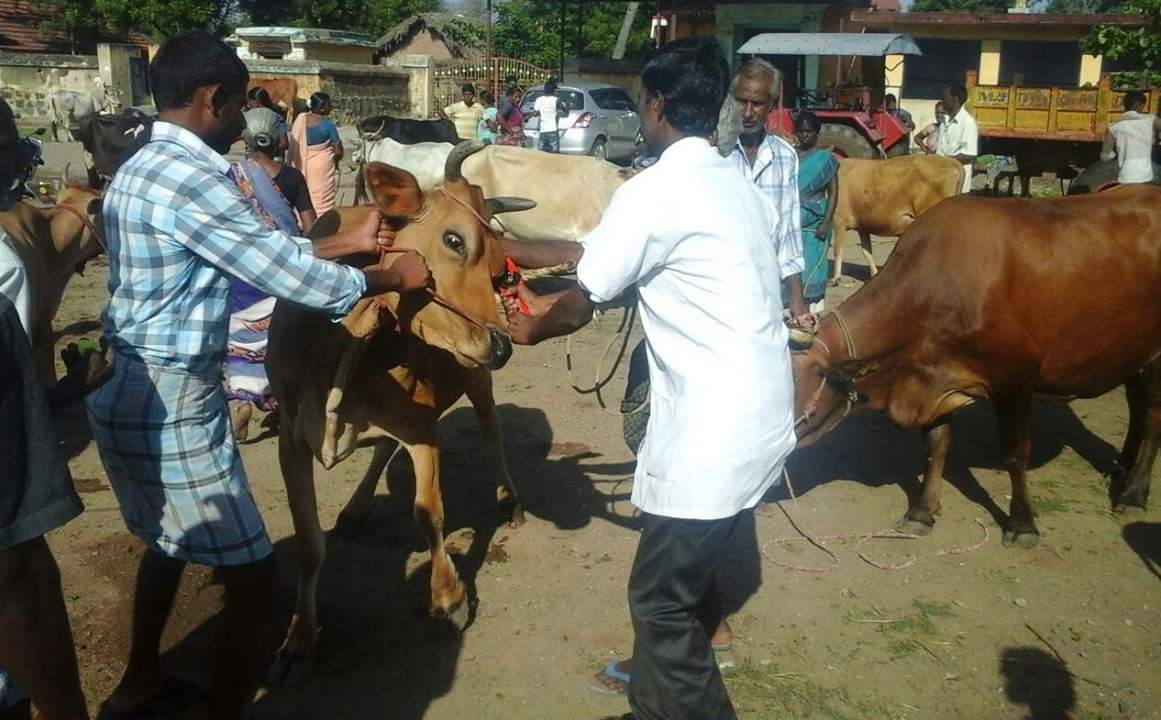
Lack of awareness, manpower shortage, ambitious target hit ear tagging of cattle

The Union government’s twin attempt to rid the country of the Foot and Mouth Disease (FMD) and digitise all cattle-related information, by 2030, has run into rough weather in Tamil Nadu due to the absence of awareness and shortage of manpower.
As per the National Animal Disease Control Programme (NADCP) of 2019, ear tagging the cattle and recording of information — age, origin, off springs etc along with the Aadhar number, address and contact number of the owner — is mandatory in get the cattle vaccinated.
Even as the state veterinarians laud the initiative, they call it cumbersome due to the requirement that they themselves ear tag the cattle, upload the information and vaccinate the cattle.
“The programme is a welcoming one. But if it is implemented without proper preparation, it becomes a burden for veterinarians, particularly in Tamil Nadu, said Dr S Veeramani, president, Tamil Nadu Veterinary Assistant Surgeons Association.
Tamil Nadu has a livestock population of around 1.2 crore. But 20 per cent of veterinarian positions are vacant. If a veterinarian is asked to just vaccinate the cattle, there is no problem. But if he is asked to ear-tag, upload information and then vaccinate, it becomes a cumbersome process affecting his routine work, he said.
“To vaccinate cattle in the state, a team of 3 members consisting of a veterinarian, a livestock inspector and an animal husbandry assistant are required. Then the team can vaccinate up to 150 cattle per day. There are sufficient veterinarians in the state but not enough livestock inspectors and animal husbandry assistants – positions for which there is a 60 per cent vacancy,” he said.
“Under these circumstances, veterinarians are pushed to vaccinate up to 250 cattle single handedly every day. Alongside, he also should ear tag and upload information which becomes a time consuming process. Therefore, he ends up vaccinating just 20 – 30 cattle per day, instead of 150 – 200 cattle as was the case in the past” added Veeramani.
Talking about the schedule, he said that vaccination needs to be administered every six months for 21 days. This year, it begins on February 28 and ends on March 21. And with only 25 lakh tags distributed till now in the state, the completion of the programme will get delayed, feels Veeramani.
Explaining the difficulties of implementing the centre’s order he said, “If one goes by the Centre’s directive on the schedule, it would take 60 – 70 days to complete the vaccination. By then, the next round of inoculation would have kicked in. And the vet would have to handle the backlog as well in addition to the routine cases in the outpatient department. Therefore, unless the issue of manpower shortage is addressed the order cannot be implemented” said Veeramani.
Talking about the lack of awareness among cattle owners, a Nagapattinam based veterinarian said that absence of publicity has come in the way of cattle owners disallowing vaccination as they believe that would reduce milk production. They are also scared of ear tagging their cattle as they believe that would tear the ears of the animals. In addition, they are of the view that the market price of ear tagged jallikattu bulls will not be encouraging, he added.
Reeling out practical difficulties in getting the job done, he further said that cattle owners would want to know if they can secure insurance or loans if they allowed ear tagging. The bank managers too are opposed to tagging the cattle if loan had been taken on them, he further added.
Also, want of village camps has forced veterinarians to travel to villages for door-to-door inoculations, which itself is time consuming besides affecting normal activities, he added.
He too agreed with the idea of ear tagging the livestock population as that would help in tackling smuggling of cattle and aid in receiving compensation in times of disasters. But he is against the implementation of the plan in a hurry just for the sake of vaccination.
India has more than 125 crore livestock population including cattle (cows and buffaloes), goats, sheep and pigs. They are prone to various diseases of which Foot and Mouth Disease (FMD) affects them most. FMD is a viral disease which infects cloven-hoofed animals. It creates wounds on the foot, mouth and in the udder of animals thereby reducing milk production.


